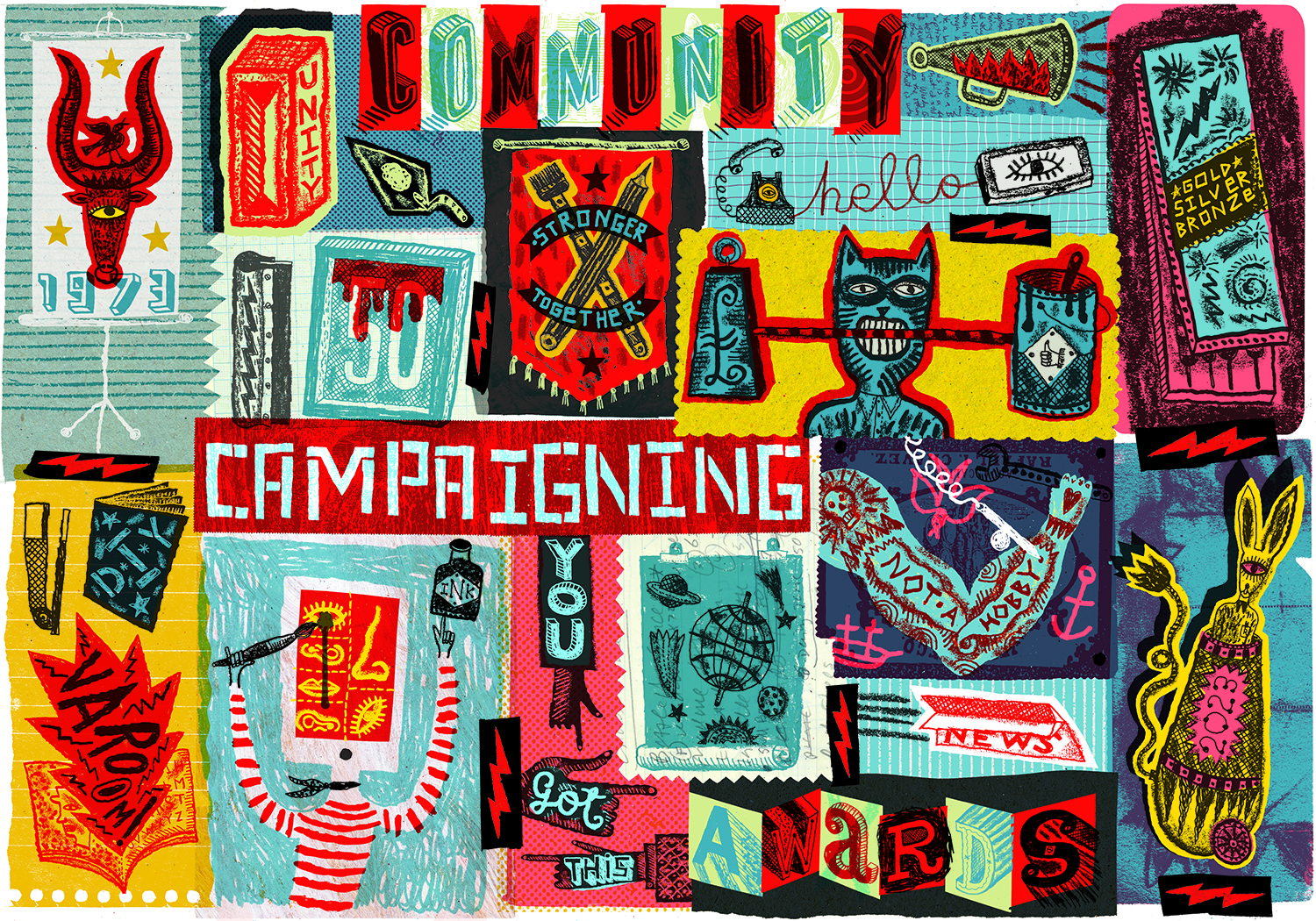
In this piece we’re celebrating the AOI’s 50th Anniversary, and what the organisation has done to improve working conditions for members (and all illustrators) from our beginnings in 1973.
Prior to the forming of the AOI, illustrators did not have a collective voice, and from the early days in 1973 right up to the issues around generative AI, illustrators’ rights have been a major focus of the AOI’s work.
Campaigning
The 1970s
The initial committee of the AOI certainly didn’t hang around after forming in 1973. By their second year they had registered as a company limited by guarantee and were arranging a Standard Job Acceptance Form (forerunner of the AOI Illustrator Commissioner Agreement) and Code of Practice for Agents and their artists, along with producing Ownership of Artwork stickers for members to attach to their physical artworks as a reminder of who owns the work – £2 for 100 stickers – a bargain! Along with their cheque for this amount, members had to include a Self-Addressed Envelope for return of the stickers. Ownership of artwork was assumed by commissioners to automatically be theirs on delivery, and once AOI disproved this in 1975, the fact was publicized widely.
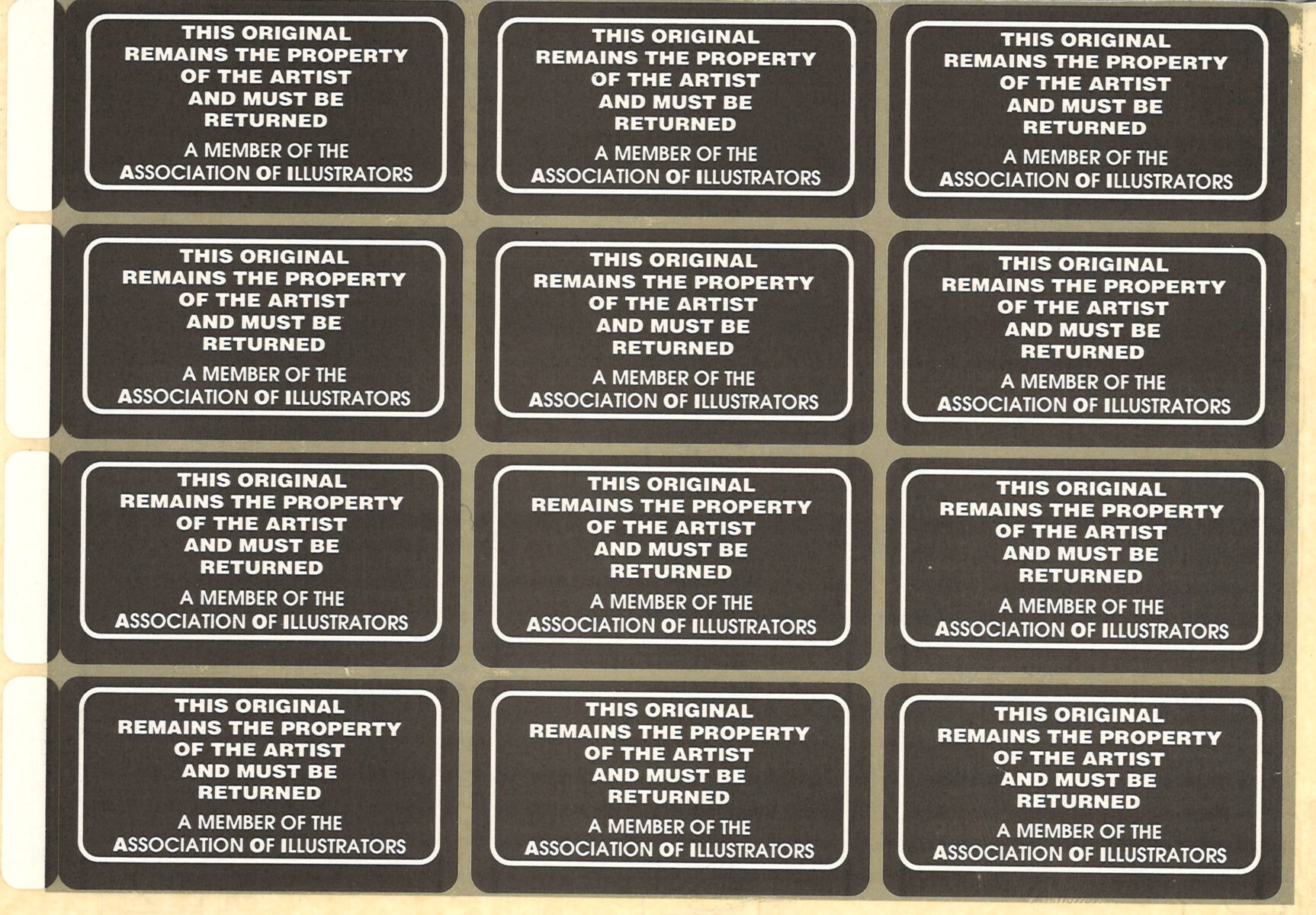 Return of Artwork stickers sheet for adding to physical artworks as a reminder to commissioners to give the illustration back to the artist!
Return of Artwork stickers sheet for adding to physical artworks as a reminder to commissioners to give the illustration back to the artist!The committee entered ongoing discussions with the Incorporated Practitioners in Advertising about accepting the Job Acceptance Form, which was eventually agreed upon, ensuring that jobs in advertising were accurately licensed. Ownership of artwork, effective commission forms, challenges to rights in work usage, all these elements are now taken for granted, but without the AOI may never have been achieved.
A less specific form of campaigning was also beneficial. As AOI Patron, Simon Stern wrote in 1998, another striking achievement of the AOI was to promote the use of illustration. ‘The market for illustration then was nothing like it is even in these somewhat diminished days (1998). There was a ready demand for very realistic illustration for paperback covers and women’s magazine fiction, there was the Radio Times printing more stylised stuff in black and white line, and there were children’s picture books and greeting cards. That was about it. But the design industry was strong and becoming more adventurous and ready for new ideas, so when the AOI published it’s bi-monthly magazine and brought out the first Best of British Illustration Annual, they found a receptive audience. Illustration was something new and fashionable, and a surprising number of commissioners became supportive members of the AOI.’
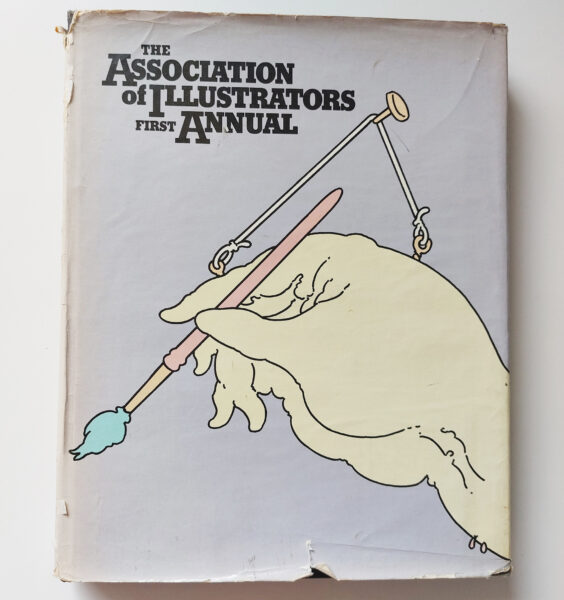 The First Annual, cover by Brian Grimwood
The First Annual, cover by Brian GrimwoodThroughout 1980s Board member, Simon Stern, wrote about ethical and legal disputes in the association’s magazine, covering disputes over money, lost original artworks and solutions for slow payments (and more) between illustrators and their clients. Campaigning work continued with issues such as IPC magazines issuing payment cheques to illustrators which had to be signed before being cashed, where the signing also assigned all rights in the artwork.
In the 1990s stock imagery (existing images that could be licensed for sometimes very low fees) was considered a possible threat to illustration and photography as images could be purchased a significantly lower prices than a bespoke commission, and there was much written about the pros and (mainly) cons of stock. A fear was that it could wipe out a level of commissions, but as time’s gone on stock has worked alongside bespoke commissioned illustration
Into the early 2000s, AOI tackled rights grabs (where a client demands all rights in an image without paying what those rights are worth), meeting with the magazine arm of the BBC in 2002 about their contract which assigned copyright and ownership of artwork to BBCWorldwide for all future work commissioned by any of their numerous magazines. There was some success in getting this revised to a licence for a number of their magazines.
Of course it wasn’t only in the UK that illustrators understood the need for representation of their interests, and twenty years ago the European Illustrators Forum (EIF)was formed, consisting of 13 illustrators’ associations from 8 countries, with the aim of safeguarding illustrators’ rights and the continental promotion of illustration through the co-ordinated action of member associations on a local level, and with a series of common initiatives on an international level, beginning with the First Illustrators Transnational Rendezvous held in Valencia in October 2003.
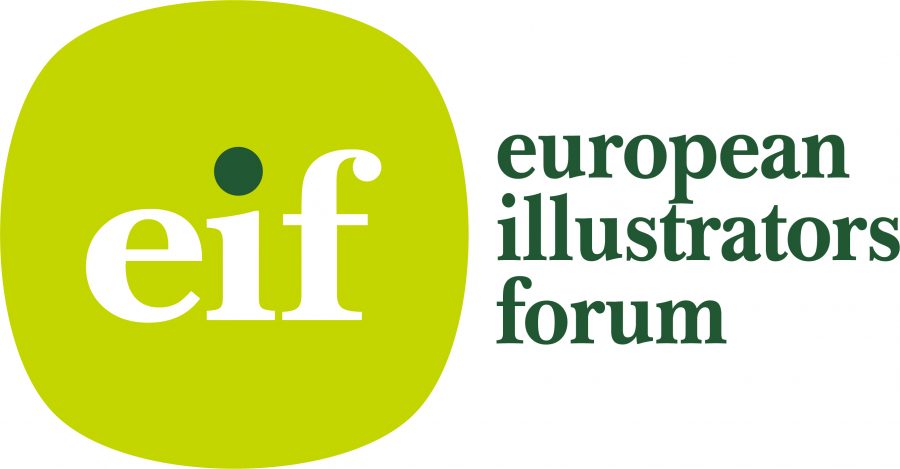
Since then, the EIF has proved to be a useful forum for keeping up with what is happening in other countries, and AOI has been President of the group for the last four years, recently overseeing a EU wide diversity survey (to be published in the near future) and AI sessions, with events held annually at book fairs as well as online. AOI has contributed much to the organisation’s success, regularly presenting talks and helpdesk advice at book fairs, such as Bologna Children’s Book Fair, under the EIF umbrella.
Sadly it’s an ongoing thing, but fee erosion, copyright grabs and the issuing of retrospective contracts from commissioners still had to be dealt with. The Pro-Action – The Illustration Campaign and Liaison Groupcommittee was established in 2006 by the AOI and the Society of Artists Agents (SAA) to deal with these problems facing illustrators. The Association of Photographers and Professional Cartoonists’ Organisation also joined.
The committee comprised of experienced professionals, including agents from Arena, Inkshed and Debut Art. The AOI’s IP lawyer, Robert Lands, became Chair of the group. The initial aims were to tackle inequitable and legally unsustainable contracts and contracting practices by commissioners, and to table a fair agent to illustrator agreement.
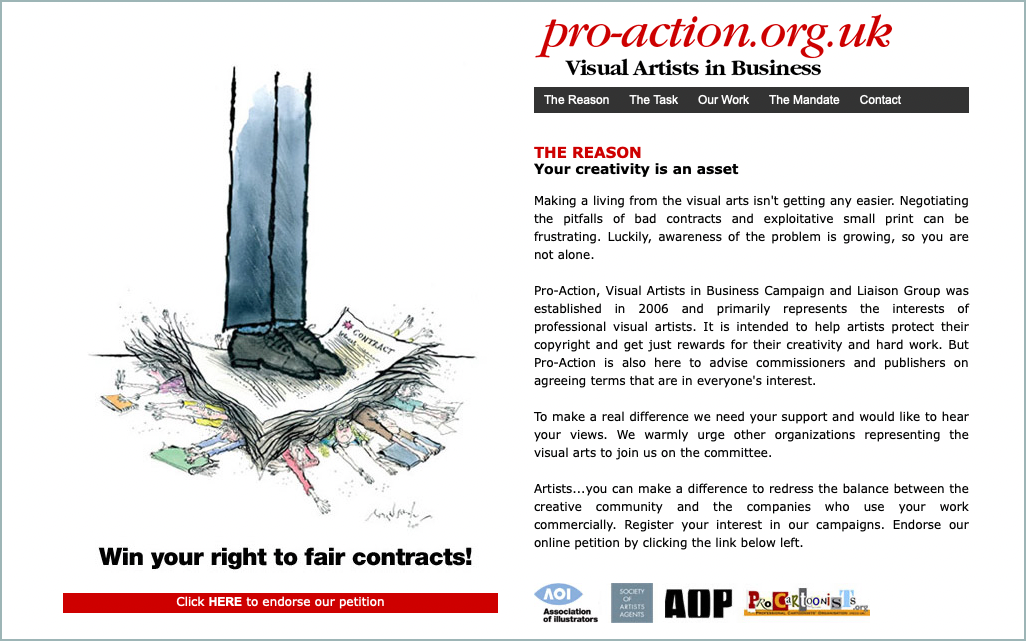 Pro-Action website with bespoke image from Patron Ronald Searle
Pro-Action website with bespoke image from Patron Ronald SearlePro-Action wanted the commissioning sector to understand the way their unfair contracts damaged their supply base by eroding illustration as a viable profession, therefore not in the sectors own best interests over the long term. Over several years, Pro-Action challenged various companies on their contract practice, including Condé Nast, Bauer, IPC, The Guardian, Future Publishing (Computer Arts), Cambridge University Press and News International, with some successes.
From 2007 on, Government launched a number of reviews looking at the UK’s copyright regime. Copyright is incredibly important to creatives, and it’s the basis on which illustrators’ make income from their works as they own their work. AOI responses were able to present the illustrator’s view to all the reviews, including the Gowers Review of Intellectual Property in 2007, the © The Future – Intellectual Property Office consultation in 2009 and significantly we submitted to the review of Intellectual Property and Growth in 2011. This consultation was set up by government to look at the existing copyright framework to decide whether it is still ‘suitable for purpose’. We said that it was, emphasising how individuals and small businesses need to be able to determine for themselves how their work is licensed – to have a choice over primary and secondary licensing, and not have it dictated by commissioning bodies.
Those consultations kept on coming, and AOI responded to a number of UK and European consultations on copyright and related issues such as Orphan Works and Extended Collective Licensing through the early 2010’s, including Extending the benefits of collective licensing; Copyright Works Seeking The Lost; Consultation on draft legislation for Copyright Exceptions; Classifying and Measuring the Creative Industries and Digital Copyright Exchange (DCE) Feasibility Study.
AOI was invited to represent illustrators on the Intellectual Property Office working groups on Orphan works and Extended Collective Licensing, allowing us to explain exactly how images are commissioned on a licensing basis.
AOI supported the use of Extended Collective Licensing (ECL) in a 2014 consultation. ECL is the basis on which sums are distributed for secondary licensing via collecting societies such as DACS, and these sums can be useful additions to illustrators’ incomes.
Government launched their Orphan Works licensing scheme in 2014. This scheme was introduced to enable the licensing of orphan works (works where the creator cannot be found or contacted), in the UK for both commercial and non-commercial use.
AOI participated on the Intellectual Property Organisation (IPO) Working Groups for the consultation, technical review and development of guidance for the scheme. The creator groups such as AOI argued that commercial use should be paid for and eventually this was part of the scheme on launch.
As you can see from earlier, there has long been issues over the contracts issued to creators in many areas from their clients, and in 2016 the Fair Terms for Creators website was set up as part of the campaign from the Creators’ Rights Alliance (AOI is a Board member) asking that creators be treated more equally when issued with contracts from all sectors. All creators are often asked to agree to contract terms they do not consider fair, but do not believe they have equal bargaining power with the client. AOI was closely involved with this campaign, which is on-going with an ultimate aim to change legislation.
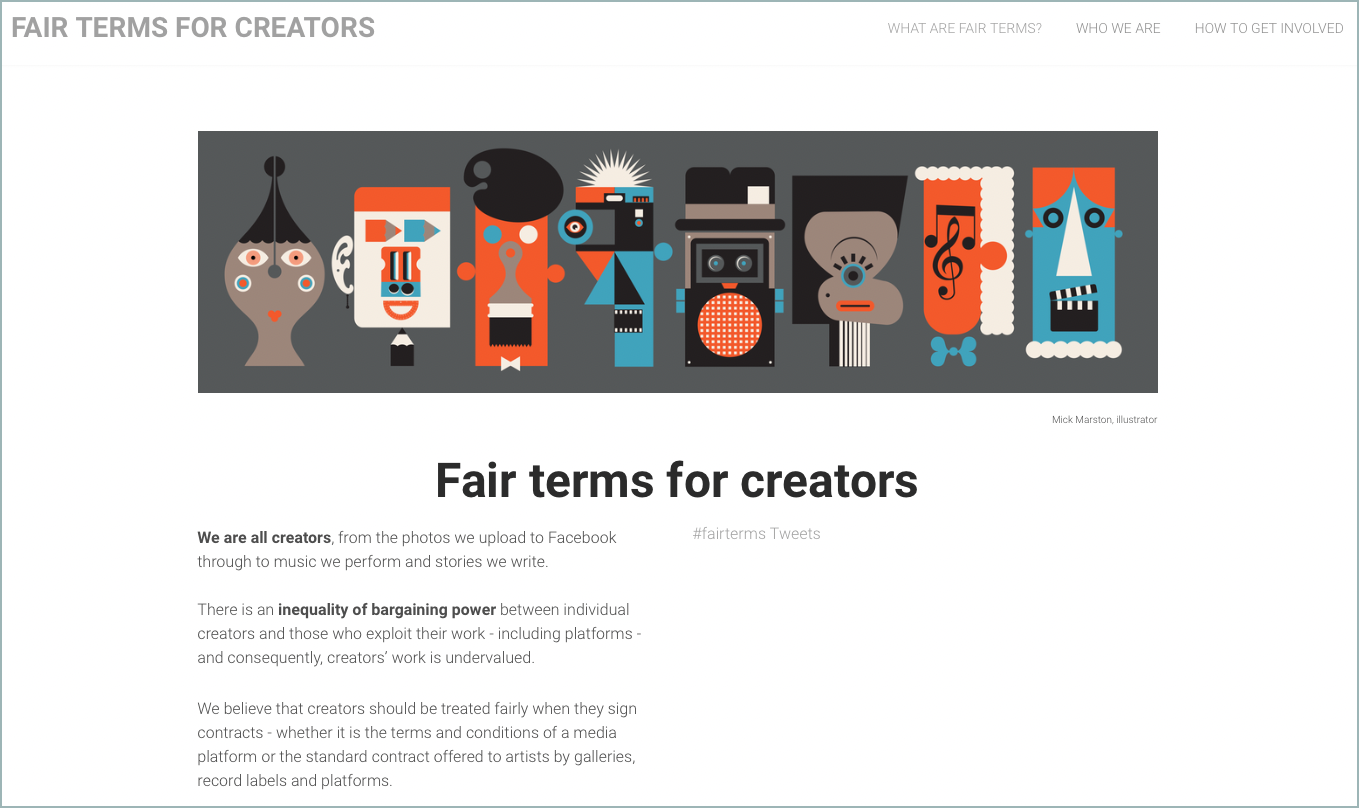 Creators Rights Alliance Fair Terms for Creators site
Creators Rights Alliance Fair Terms for Creators siteWhile ensuring that the voice of illustrators is heard in consultations with government, AOI has continued to launch campaigns which focus on improving the perception of illustration and encouraging recognition of illustration’s value in the marketplace. This has included 2018’s Price It Right campaign supporting illustrators and commissioners to be confident in how illustration is priced, with resources to assist all illustrators. The campaign, run along with the EIF, is still relevant and has three main aims: Increasing understanding and confidence in pricing illustration; Ensuring Illustration is valued and Supporting business. Nishant Choksi created a great logo for the campaign.
We’ve continued with our own Not A Hobby campaign, encouraging illustrators to manage their businesses successfully and for the whole industry to understand and respect licences, contracts and fair pay, along with addressing the rise in mental health in our industry.
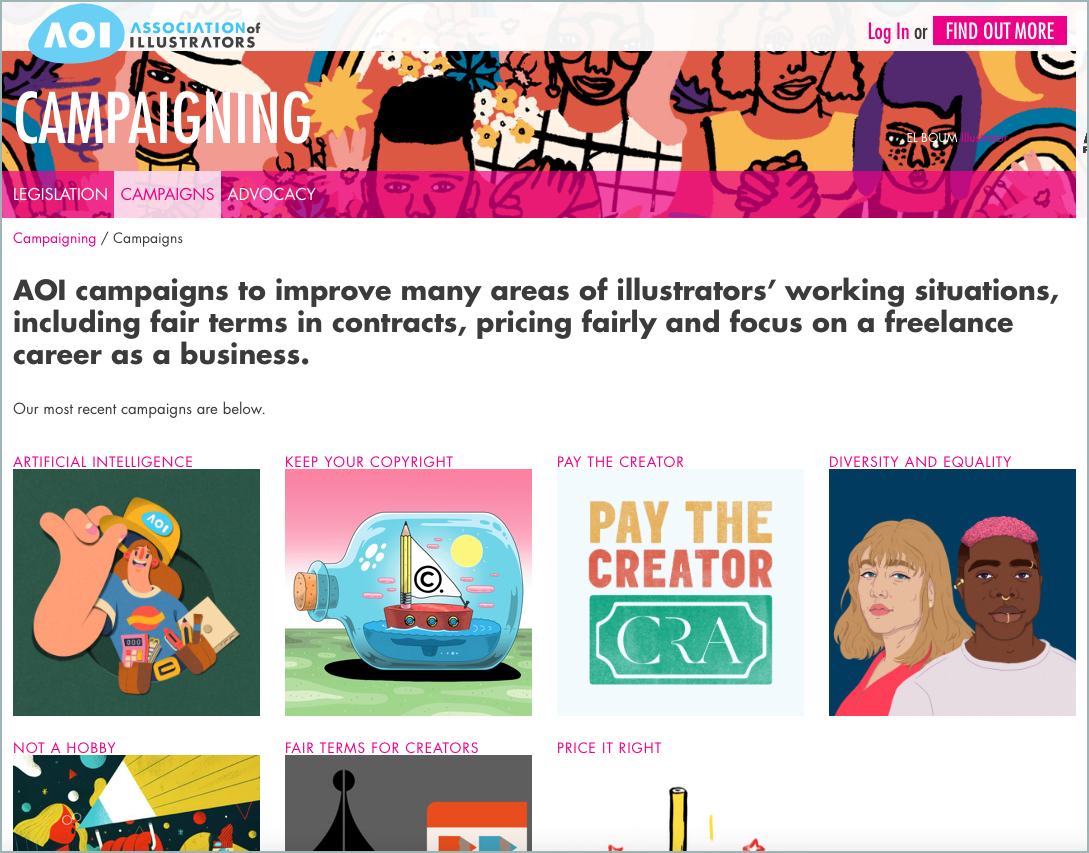 AOI Campaigning page
AOI Campaigning pageFollowing that, the Keep Your Copyright campaign was started with the objectives to protect licensing-based industries, and AOI called on illustrators and commissioners to unite and push back on copyright assignments. We aimed to empower illustrators by equipping them with the tools they need to understand copyright and licensing, and how to negotiate better contractual terms with confidence.
Pay the Creator, launched in 2022, is a Creators’ Rights Alliance campaign calling for creators to be paid professionally and promptly, and to be given the same considerations enjoyed by other workers in the areas of pay, business support and policy making. This acts as an umbrella campaign for CRA members to hang their separate campaigns under.
In autumn 2022 Government were proposing a copyright exception for ‘text and data mining’ (TDM – the scraping of content from the internet), which would allow any use of scraped content, even commercially. We sent out a survey to gather further information on the impact the TDM exception will have on UK illustrators, and at that time 97% of respondents stated that they were opposed to their illustrations being used for artificial intelligence or machine learning purposes without their permission.
In early 2023 AOI published our initial statement on artificial intelligence/machine learning recognising illustrators concerns in the area and stating that only data where the owner has given explicit permission should be used by AI for training.
The number of AI platforms offering generative AI works continued to increase, and in Spring 2023 the Government issued a white paper consultation on the regulation of AI and how that could be done. AOI responded with the illustrators’ view, emphasising that illustrators require protections and safeguards where technology is applied, and pointing out concerns over the unauthorised use of images to train AI/Machine learning for text to image platforms, and around possible undermining of illustrators’ livelihoods by AI generated imagery.
We aim to inform and help illustrators navigate this changing AI landscape as it develops and to share different perspectives from within our community. To find out more about AI developments and campaigning see our AI Updates resource page, which contains links to related news articles and opinion pieces.
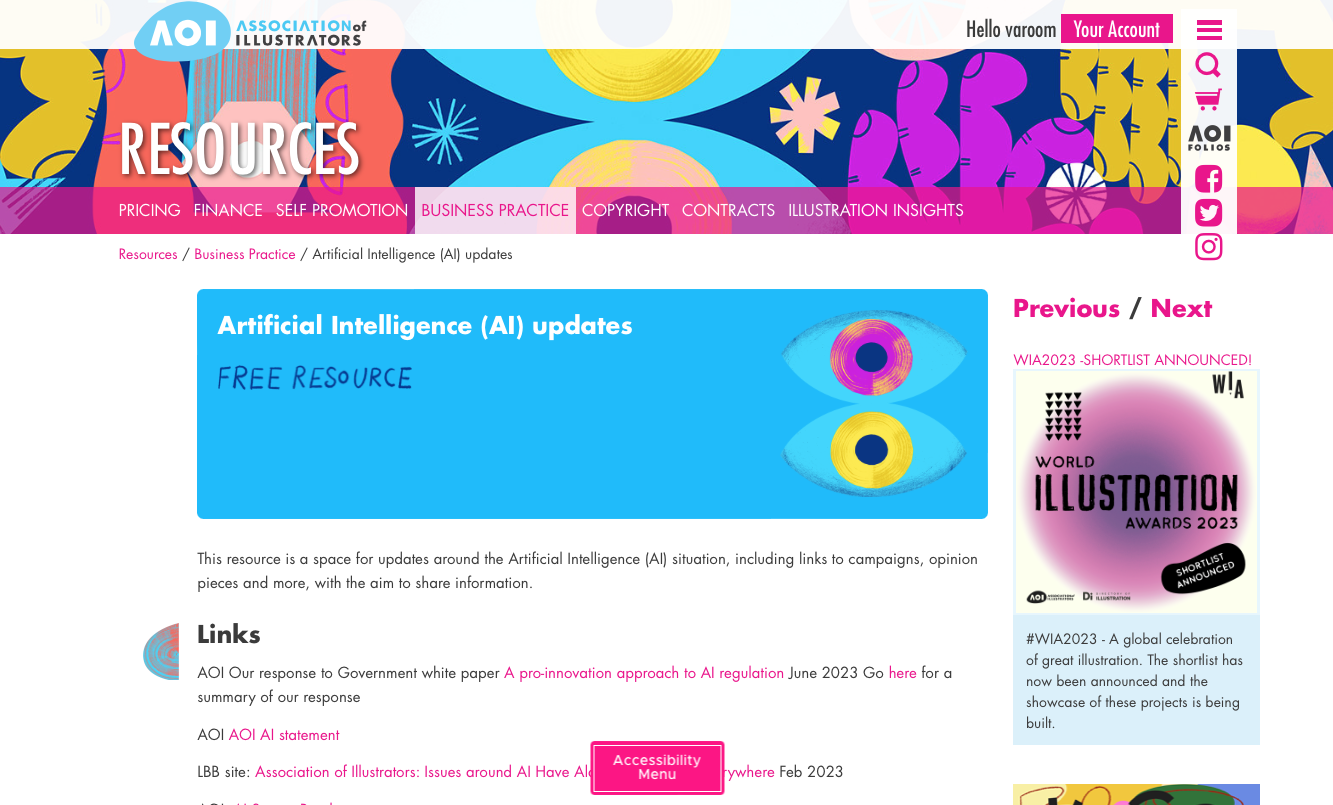 AOI Resources, AI Updates page
AOI Resources, AI Updates pageNothing stays the same, and AOI has helped achieve many positive changes in working practice for all illustrators, whether they are members or not. From ensuring that commissioned artwork was legally retainable by artists, via an essential Illustrator-to-Commissioner agreement, to representing illustrators’ views to Government on a host of important issues, we intend to keep on campaigning to protect your interests.
AOI 50th anniversary illustration and logo by Jonny Hannah
More on our Anniversary
AOI 50th Anniversary – Here for the members! Fifty years of support for illustrators
AOI 50th Anniversary – Awards and Events From the first annual in 1976 to World Illustration Awards
AOI 50th Anniversary – I was there! Recollections from important AOI contributors
AOI 50th anniversary – 5 major achievements